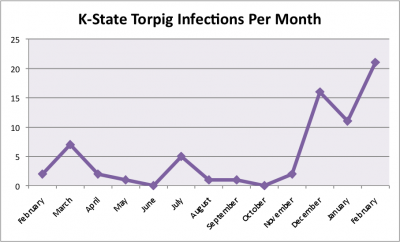Silently sneaking onto your computer, Torpig lies in wait for you to log in to your bank’s website and sends your account information to well-organized criminals. Torpig has found its way on to more than 70 computers at K-State in the last year, and the number of infections is on the rise. The chart below shows infections from February 2009 through February 2010.
Unfortunately, security technology can’t always prevent infection because the malicious software changes rapidly and uses sophisticated stealth techniques to hide itself on infected computers. Thus, once again the user plays a key role in preventing infection and financial fraud.
Torpig, also known as Sinowal or Anserin, is malicious software belonging to the Trojan horse family that is designed to steal sensitive information from the computer that it infects. It specifically targets personal and corporate financial information such as credit card data, usernames, and passwords used in the victim’s web browser. It’s constantly changing and evolving and employs rootkit functionality to make it very difficult to detect and remove.
Torpig initially infects computers in several different ways. Continue reading “Torpig malware threatens K-Staters' bank account information”
